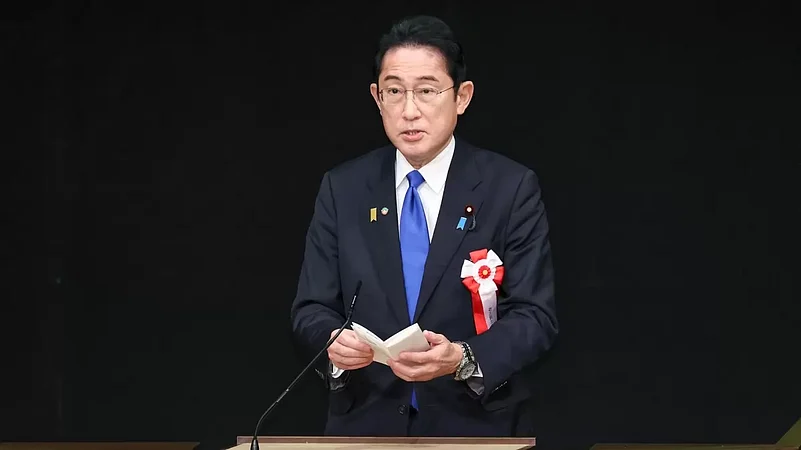Ever since the Japanese press reported that Prime Minister Fumio Kishida is set to announce a new Quad initiative to promote a free and open Indo-Pacific during his visit to New Delhi, there is anticipation about what he has to offer.?
Japanese PM Kishida Arrives In India Today, To Launch A New Quad Initiative
Japan’s Prime Minister Kishida will discuss his Quad plans with Prime Minister Narendra Modi during his visit. India will be happy to see the focus shift from the distant war in Europe to issues that affect lives in the Indo-Pacific, including China’s aggressive moves in Asia.

Kishida, struggling domestically to keep his squabbling party members united, is hoping to make his mark in foreign policy. With China looming as a threat across the Indo-Pacific, he is eager to invigorate the Quad and ensure that the group works together to thwart Chinese influence in a region where Beijing through its enormous military and economic might wields enormous clout.
In a major speech to Indian Parliament in 2007, Kishida’s predecessor Shinzo Abe spoke of the confluence of the two seas and promoted the idea of joining the Pacific and Indian oceans to advocate for a broader Asia. Abe’s idea is now an accepted fact with the Indo-Pacific meaning just that. He spoke with passion of the arc of freedom and prosperity. Today, the arc of freedom is being replaced by the American term “free and open Indo-Pacific” but in reality, there is no difference between the two which is at the heart of the Quad.?
Unfortunately, the Quad did not survive the political changes that followed. Abe stepped down as Prime Minister of Japan in September 2007 without completing his full term. The Quad fizzled out on the back of loud protests by China and Australian elections that brought Labor Party’s Kevin Rudd to power. Rudd, unlike his Conservative predecessor, believed that Australia’s economic well-being was tied to China and advocated better ties with Beijing. The Quad was revived 10 years later in 2017. ? ? ?
Like Abe, Kishida, who arrives in New Delhi on Monday, has also chosen India to spell out his plans for the Quad. Japan and India both have long-standing territorial disputes with China. India and China fought a border war in 1962 while in 2020 there was a clash between the Indian and the PLA soldiers in Galwan Valley in Eastern Ladakh. The border between India and China has not yet been demarcated in many areas and China is increasingly sending its troops across the Line of Actual Control (LAC) both in the eastern and western sectors.
Japan and China lay claim to a group of uninhabited islands known as Senkaku in Japan and Diaoyu islands in China and tension escalates whenever Chinese ships come into Japan’s territorial waters. The history of animosity between the two go back to the time of World War II when the imperial Japanese army invaded and occupied large swathes of Chinese territory. China remembers the atrocities committed by the Japanese during that period.
Kishida is hoping for India to back its Quad plans at a time when “it is keen to deepen relations with India, a key nation of the Global South”. Quoting the Foreign Office spokesperson Ona, the Japan Times reported, “Kishida’s proposal would include the provision of non-military equipment and infrastructure support for nations in the Asia-Pacific region that have been facing threats from Beijing’s military build-up in the South China Sea.” Japan wants to expand development aid to countries hit by the war in Ukraine as well as the after-effects of the long pandemic shutdown.?
This falls in place with India’s vision of its role as leader of the developing world. Ahead of the G-20 finance minister’s meeting in Bangalore, India organised a virtual summit of developing nations to discuss the problems that these nations were facing since the beginning of the Covid-19 pandemic and the rising cost of fuel and food following the Ukraine War. The economic help that poorer nations need is an important element of what India hopes to focus at G-20. If Kishida wants to stretch a helping hand to poorer countries of the Indo-Pacific, India will more than welcome the move.
Kishida will hold the annual India-Japan Summit with Prime Minister Narendra Modi. The Summit has been part of the diplomatic calendar since former Prime Minister Dr Manmohan Singh’s tenure. Kishida’s short visit would not just concentrate on bilateral ties, which are moving in the right direction, but would also involve exchange of views on crucial regional and international issues. The Quad as well as Russia’s war in Ukraine will be an important part of the conversation.
There will be an attempt by the two leaders to harmonise their respective positions regarding the G-20 Summit in September hosted by India and G-7 Summit scheduled for May in Hiroshima in Japan. Kishida is expected to invite Modi to attend the G-7 summit.
The long shadow of the war in Europe is being cast over every international conference since February 2022. Getting members to agree on Ukraine is becoming a difficult task. G-20 is no exception as the recent meeting of the finance and foreign ministers in Bangalore and Delhi showed.
Indian leaders will be keen to hear from Kishida his new Quad strategy. New Delhi would like the focus to shift to China and bread and butter issues rather than the distant war in Europe.
-
Previous Story
 Israel-Hamas War: Angry Israelis Protest For Hostage Deal, Urge Netanyahu To 'Sign Deal Now'
Israel-Hamas War: Angry Israelis Protest For Hostage Deal, Urge Netanyahu To 'Sign Deal Now' - Next Story


















